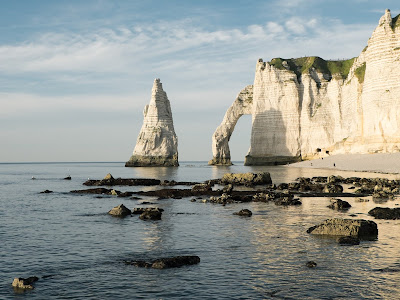 |
| Beautiful Normandy, France |
and the 75th anniversary of the D-day invasion in Normandy, two weighty topics back to back. The combination of these two events made me wonder about the effect that World War II had on the environment. The answer is “wide-spread and ongoing” and quite eye-opening.
WWII was fought or felt in virtually every corner of the world, with the two main fronts being the Pacific (War in the Pacific) and Europe (The European Theater). Many of the key fighting nations had far-flung colonies that were not in these areas; but they pulled soldiers and resources from them, so distance was not a shelter for citizens of those countries. Even those parts of the world that were spared fighting in their homeland were not spared the economic and (as we shall see) environmental effects.
I found a really interesting site that clearly explains how WWII came to be by using a series of maps, check it out here.
 |
| Alfonton Ortega from LA making crosses after D-day |
Somewhere between 50 and 80 million people died worldwide. This includes military and civilian deaths and deaths due to famine and disease. The nations that suffered most were the Soviet Union, with 22-28 million dead and China (fighting the Japanese) with 15-20 million gone. Amongst the dead would have been the caretakers of the land, those that dredged out waterways, disposed of waste, managed fish and wildlife resources, planted trees, etc. Not to mention those with academic knowledge about the environment, such as scientists and teachers. A gruesome truth is that not only were these people gone, but their corpses caused an ecological disaster in and of themselves. In the aftermath of a battle, military equipment, salvageable items and general booty would have been taken by troops or locals. Often the dead were left where they were. In places such as Eastern Europe/Western Russia (where there had been massive loss of life in horrible conditions), the land could not be plowed after the war – there were simply too many bones to be able to get a plow through. To this day, people are still going out and removing bodies for re-internment.
 |
| Vanuatu, South Pacific |
By now, I expect many of my readers to be wondering about whether I will talk about the atomic bombs dropped on Hiroshima and Nagasaki in Japan. This is arguably the biggest environmental concern ever, much less what came out of WWII, but it is also so much more and there is just too much there to wade into in this blog and do any of it justice. If you'd like to learn more and watch a short video, go here.
Toxic shipwrecks were and are still a problem in the Atlantic; especially following such big events as Dunkirk and D-day.Trace amounts of oil can still be detected in these waters from the ships that were lost.
 |
| Bocage district, western France |
 |
| Aftermath of WWII, France |
The recovery that Europe made after the war is nothing short of phenomenal. Starting with nothing but the need to survive and a renewed respect for teamwork, land was slowly returned to viability and new and improved social orders were formed.
The environmental effect of WWII goes far beyond what one can point to: goods needed for the war effort created new technologies and a military-industrial complex that needed new sources and infrastructure to support it. Chemical, munitions and aviation factories, working non-stop, required large amounts of electricity and pumped out lots of dirty emissions. The need to win the war, and fast, trumped any misgivings about long-term detriments. The post-war civilian demand for what these factories created (plastics, synthetics, pesticides, herbicides, petroleum-based products, medicines, aluminum and more) meant that this industrial beast stayed fed.
After decades of continued industrialization, many parts of the US were blanketed by smog and waterways churned with pollutants. There had been early voices of concern about war-related pollution, but it took until you could literally see the pollution before the environmental movement became part of the social zeitgeist and people were willing to fight for change. Although environmental issues are more widely accepted than ever, we still have a long way to go to overcome complacency. Here at ARBICO Organics, we will continue to do what we’ve been doing for the last 40 years – offering earth-friendly alternatives and keeping poisons out of our world one customer at a time.
Submitted by Pam






No comments:
Post a Comment